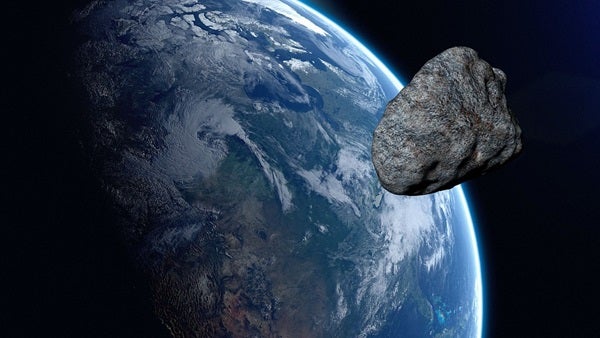Earth had a close encounter this morning when Asteroid 2019 OK sped by at 1:22 GMT, at a speed of nearly 55,000 miles (88,500 kilometers) per hour. The closest it came to Earth was just under 45,000 miles (72,500 km), a safe distance, but still much less than the distance between the Earth and Moon.
Astronomers only noticed the space rock within the past few days, when astronomers at SONEAR Observatory in Brazil picked it up. Because it’s such a newcomer, there’s still a lot astronomers aren’t sure about, from its orbit to its size, which ranges between 187 to 426 feet (57 to 130 meters) across.
While Earth gets a few asteroid visitors that buzz closer than the Moon every year, this one is the largest so far in 2019.
Close call
NASA and other space agencies keep close tabs on Near-Earth Objects, those space rocks whose paths come even remotely close to our planet’s orbit. NASA considers it their main avenue of planetary defense, and has been charged by Congress to find at least 90 percent of NEOs 460 feet (140 m) across and larger. Asteroids smaller than that probably wouldn’t cause a planet-scale catastrophe, though they could be quite damaging, depending on where they hit.
For reference, the asteroid purported to have killed the dinosaurs 66 million years ago was about 10 miles (16 km) across, if not larger, while the meteor that flew over Chelyabinsk, Russia in 2013 was only 66 feet (20 m) across.
So if 2019 OK had struck Earth, it could have delivered quite the blow to any city it struck, but would not have been a world-wide event. Experts suggested it would hit with some 30 times the power of the atomic bomb that destroyed Hiroshima.
But the real effects are unclear, because there’s still uncertainty about how big the asteroid was. The large range, between 187 and 426 feet (57 to 130 m), occurs because astronomers can really only measure how bright the object is. A shinier object could be on the smaller end of the range, while a darker, less shiny target might be on the larger end.
Often, NASA and other observatories spot asteroids the size of 2019 OK when they’re much farther from Earth, giving more lead time to understand and, if necessary, prepare for a meteor strike. But in this case, the asteroid approached not from the dark of deep space, but from the Sun.
Just as baseball players have trouble spotting balls when the Sun is in their eyes, so too do telescopes have a harder time tracking small objects when they’re closer to the Sun.
It’s possible other such objects likewise sneak by Earth under cover of light. But the bigger the asteroid, the harder it is to hide, and NASA is keeping their eyes open.










